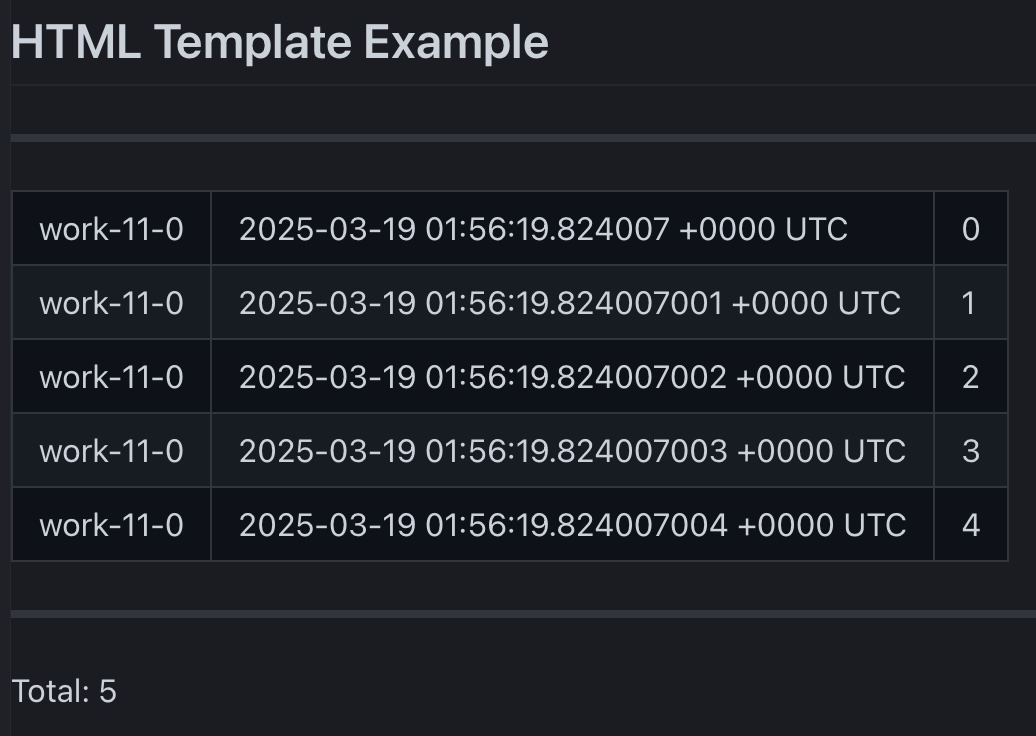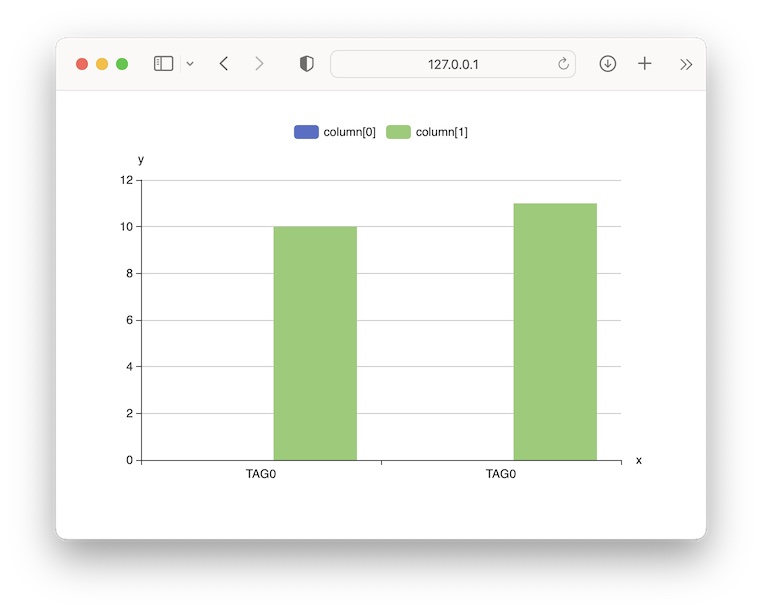As Reading API
CREATE TAG TABLE IF NOT EXISTS EXAMPLE (
NAME VARCHAR(20) PRIMARY KEY,
TIME DATETIME BASETIME,
VALUE DOUBLE SUMMARIZED);
INSERT INTO EXAMPLE VALUES('TAG0', TO_DATE('2021-08-12'), 10);
INSERT INTO EXAMPLE VALUES('TAG0', TO_DATE('2021-08-13'), 11);TQL 스크립트를 저장하면 편집기 우측 상단에 ![]() 아이콘이 표시됩니다. 클릭하면 스크립트 주소를 복사할 수 있습니다.
아이콘이 표시됩니다. 클릭하면 스크립트 주소를 복사할 수 있습니다.
CSV
아래 코드를 output-csv.tql로 저장해 주십시오.
| |
curl 명령으로 TQL을 호출해 주십시오.
$ curl http://127.0.0.1:5654/db/tql/output-csv.tqlTAG0,1628694000000000000,10
TAG0,1628780400000000000,11아래 코드를 output-csv.tql로 저장해 주십시오.
| |
curl 명령으로 TQL을 호출해 주십시오.
$ curl http://127.0.0.1:5654/db/tql/output-csv.tqlTAG0|1628694000000000000|10
TAG0|1628780400000000000|11JSON
아래 코드를 output-json.tql로 저장해 주십시오.
| |
curl 명령으로 TQL을 호출해 주십시오.
$ curl http://127.0.0.1:5654/db/tql/output-json.tql{
"data": {
"columns": [ "NAME", "TIME", "VALUE" ],
"types": [ "string", "datetime", "double" ],
"rows": [
[ "TAG0", 1628694000000000000, 10 ],
[ "TAG0", 1628780400000000000, 11 ]
]
},
"success": true,
"reason": "success",
"elapse": "770.078µs"
}아래 코드를 output-json.tql로 저장해 주십시오.
| |
curl 명령으로 TQL을 호출해 주십시오.
$ curl http://127.0.0.1:5654/db/tql/output-json.tql{
"data": {
"columns": [ "NAME", "TIME", "VALUE" ],
"types": [ "string", "datetime", "double" ],
"cols": [
[ "TAG0", "TAG0" ],
[ 1628694000000000000, 1628780400000000000 ],
[ 10, 11 ]
]
},
"success": true,
"reason": "success",
"elapse": "718.625µs"
}아래 코드를 output-json.tql로 저장해 주십시오.
| |
curl 명령으로 TQL을 호출해 주십시오.
$ curl http://127.0.0.1:5654/db/tql/output-json.tql{
"data": {
"columns": [ "NAME", "TIME", "VALUE" ],
"types": [ "string", "datetime", "double" ],
"rows": [
"TAG0", 1628694000000000000, 10,
"TAG0", 1628780400000000000, 11
]
},
"success": true,
"reason": "success",
"elapse": "718.625µs"
}아래 코드를 output-json.tql로 저장해 주십시오.
| |
curl 명령으로 TQL을 호출해 주십시오.
$ curl http://127.0.0.1:5654/db/tql/output-json.tql{
"data": {
"columns": [ "NAME", "TIME", "VALUE" ],
"types": [ "string", "datetime", "double" ],
"rows": [
{ "NAME": "TAG0", "TIME": 1628694000000000000, "VALUE": 10 },
{ "NAME": "TAG0", "TIME": 1628780400000000000, "VALUE": 11 }
]
},
"success": true,
"reason": "success",
"elapse": "718.625µs"
}NDJSON
아래 코드를 output-ndjson.tql로 저장해 주십시오.
| |
curl 명령으로 TQL을 호출해 주십시오.
$ curl http://127.0.0.1:5654/db/tql/output-ndjson.tql{ "NAME": "TAG0", "TIME": 1628694000000000000, "VALUE": 10 }↵
{ "NAME": "TAG0", "TIME": 1628780400000000000, "VALUE": 11 }↵
↵MARKDOWN
아래 코드를 output-markdown.tql로 저장해 주십시오.
| |
curl 명령으로 TQL을 호출해 주십시오.
$ curl http://127.0.0.1:5654/db/tql/output-markdown.tql|NAME|TIME|VALUE|
|:-----|:-----|:-----|
|TAG0|1628694000000000000|10.000000|
|TAG0|1628780400000000000|11.000000|아래 코드를 output-markdown.tql로 저장해 주십시오.
| |
curl 명령으로 TQL을 호출해 주십시오.
$ curl http://127.0.0.1:5654/db/tql/output-markdown.tql<div>
<table>
<thead>
<tr><th align="left">NAME</th><th align="left">TIME</th><th align="left">VALUE</th></tr>
</thead>
<tbody>
<tr><td align="left">TAG0</td><td align="left">1628694000000000000</td><td align="left">10.000000</td></tr>
<tr><td align="left">TAG0</td><td align="left">1628780400000000000</td><td align="left">11.000000</td>
</tr>
</tbody>
</table>
</div>HTML
HTML() 함수는 제공된 템플릿 언어를 활용해 결과를 HTML 문서로 출력합니다.
쿼리 결과에 맞춰 HTML 구조와 스타일을 자유롭게 구성하실 수 있습니다.
{{ .V.column_name }}처럼 컬럼 값을 읽거나, {{ if .IsFirst }}, {{ if .IsLast }} 조건을 이용해 첫 행과 마지막 행에 맞춘 템플릿 제어가 가능합니다. 이를 활용하면 표, 보고서 등 다양한 HTML 표현을 TQL 스크립트만으로 생성할 수 있습니다.
| |

CHART
TQL 파일 저장
아래 코드를 output-chart.tql로 저장해 주십시오.
| |
HTTP GET
웹 브라우저에서 http://127.0.0.1:5654/db/tql/output-chart.tql 주소를 열어 주십시오.

기존
CHART_LINE(),CHART_BAR(),CHART_SCATTER()계열 함수는 새로운CHART()함수로 대체되었습니다.
예시는 CHART() 문서를 참고해 주십시오.
chartJson() 활용
TQL 파일 저장
아래 코드를 output-chart.tql로 저장해 주십시오.
| |
HTTP GET
웹 브라우저에서 http://127.0.0.1:5654/db/tql/output-chart.tql 주소를 열어 주십시오.
{
"chartID":"MzM3NjYzNjg5MTYxNjQ2MDg_",
"jsAssets": ["/web/echarts/echarts.min.js"],
"jsCodeAssets": ["/web/api/tql-assets/MzM3NjYzNjg5MTYxNjQ2MDg_.js"],
"style": {
"width": "600px",
"height": "600px"
},
"theme": "white"
}chartID() 활용
TQL 파일 저장
아래 코드를 output-chart.tql로 저장해 주십시오.
| |
HTTP GET
웹 브라우저에서 http://127.0.0.1:5654/db/tql/output-chart.tql 주소를 열어 주십시오.
{
"chartID":"myChart",
"jsAssets": ["/web/echarts/echarts.min.js"],
"jsCodeAssets": ["/web/api/tql-assets/myChart.js"],
"style": {
"width": "600px",
"height": "600px"
},
"theme": "white"
}